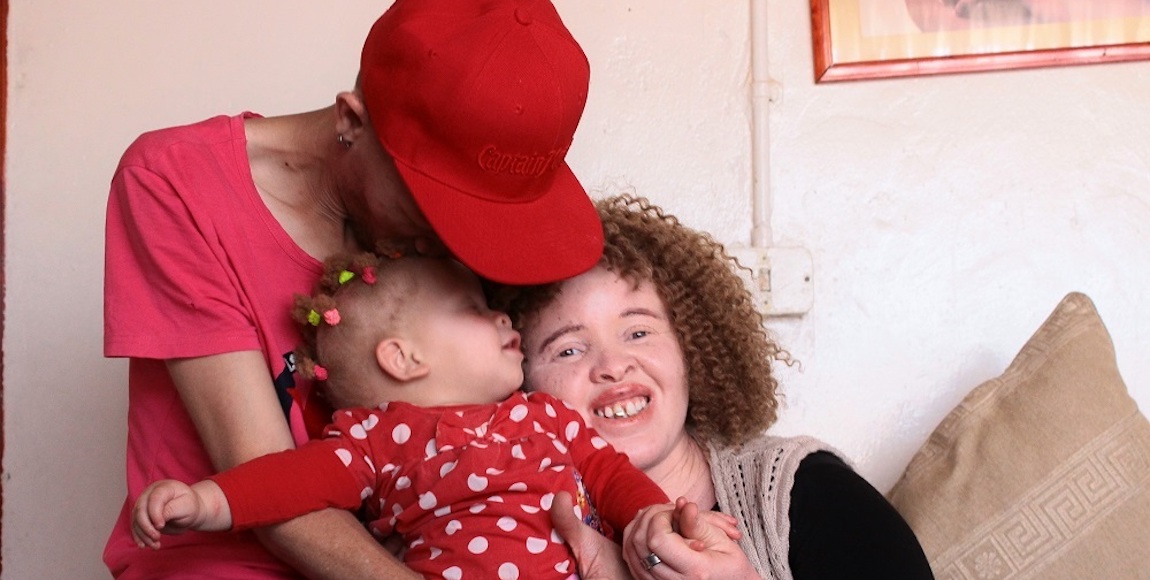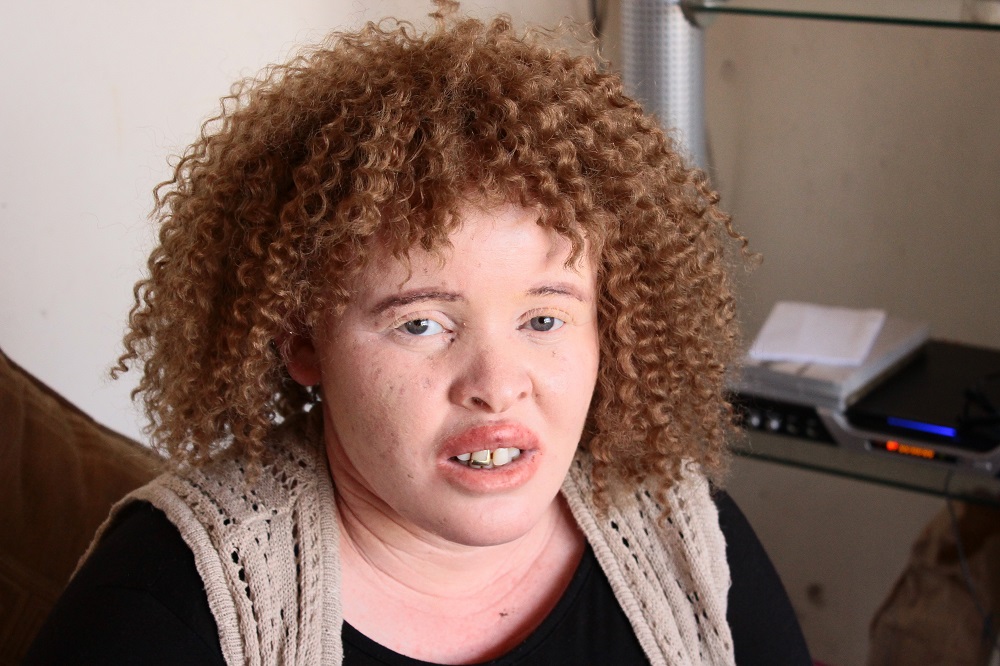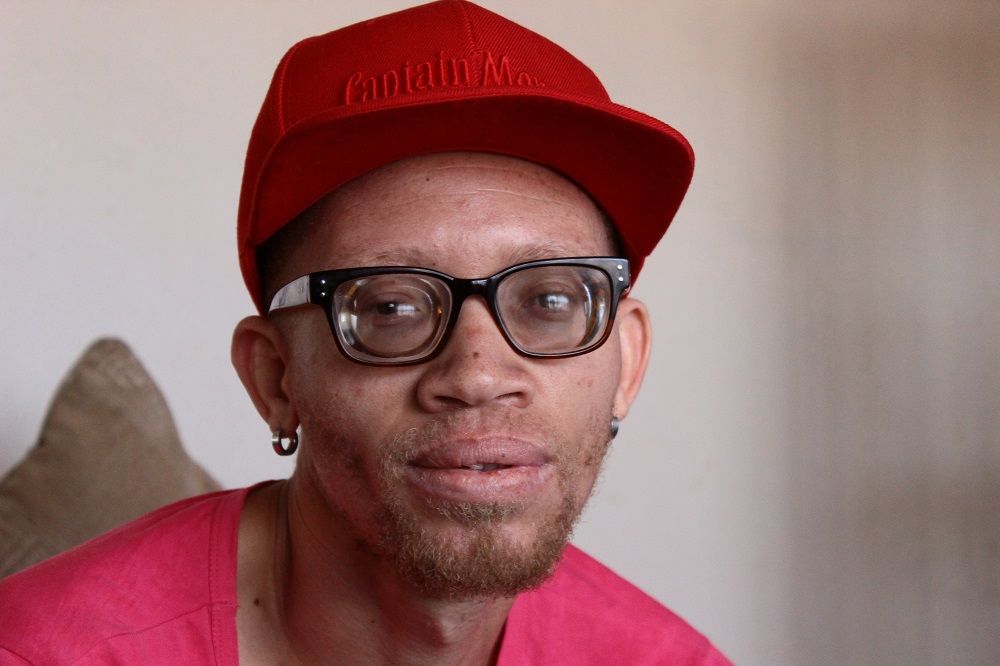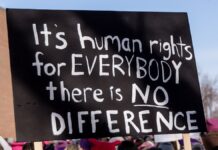Mafusi Tampe and Lebo Kgopane are a young couple living in Soweto with a boisterous eight-month-old girl. Both have albinism, and little Diteboho does too. With their blonde hair, pale eyes, and fair skin, the three look similar, but their everyday needs and challenges are different.
Tampe and her brother both have albinism. Growing up, her parents did not shy away from recognising that fact, and Tampe believes this helped her become resilient to the stares and being called “pinky-pinky”. “My parents taught my brother and I about albinism. Even if you go out and people would say ‘Oh, an albino, it was just a compliment because at home they had already told us or called us that. We know who and what we are.”
Kgopane’s childhood was quite different. He was the only one in his family with albinism and his mother never explicitly talked to him about his condition. I didn’t notice that [I was different]. Everyone at home loved me so I didn’t feel different. There were moments when I was six or seven where I’m like okay, I’m kinda white and they’re black. But it didn’t bother me,” he says.
Albinism is a congenital condition, meaning it is present from birth, and no amount of spitting in your shirt, as the age-old myth holds, will prevent you from having a child with the condition. It’s either you have the faulty gene or not. Clinical geneticist Dr. Louisa Bhengu says albinism occurs when an individual inherits, from each parent, two faulty copies of the genes that control pigmentation. Albinism is a rare but common genetic disorder with about 1 in 4 000 to 5 000 people as carriers. If you are a carrier, there is a 75% chance that your baby will be born with normal pigmentation levels.
“We [black people] are more likely to have a baby that has albinism. The carrier risk is high in the black population,” said Bhengu.
People with albinism can’t produce or have very low levels of melanin, a pigment found in the skin. This results in the characteristic fair to pale skin, hair, and eyes. Melanin plays a much more important role than simply determining the lightness or darkness of a person’s skin. It also protects the body from sun damage.
Because of the low to zero levels of pigmentation in their skin, people with albinism have a much higher risk of skin damage. “That’s why when we’ve made a diagnosis, we will definitely advise skin protection from the sun rays because the rays can damage the skin and cause ulcers,” said Bhengu.
Tampe has very sensitive skin and relies on sunblock throughout the day to protect herself from sunburn. She applies sunscreen every two hours, including before she goes to bed. “If I get burnt by the sun, I see it immediately. [My skin] changes and later the redness turns into blisters. I have to pop them and when they’ve healed they form those brown spots,” she said, pointing to her legs.

Kgopane can get away without using sunblock. “My skin is a bit stronger. I can go a whole month without applying sunblock. In summer, I can apply once a week.”
The other major medical issue for people with albinism is poor eyesight.
Ophthalmologist Dr Akiel Asvat told The Daily Vox that when people have albinism, a part of the retina is underdeveloped. “Ninety percent of vision comes from the fovea, which lies on your retina, and in albinism patients, some don’t develop that area completely,” he said. They can also have jerky, involuntary eye movements (known as nystagmus) and light sensitivity. This makes it hard for the eye to focus clearly.
Kgopane has worn thick glasses since he was nine years old, and he has to consult an eye specialist regularly. “Things have to be really close for me to see,†he says.
He has been hit by cars while crossing the street on three separate occasions. His poor eyesight has also affected his education and was kept back a grade.
“When I started school I never saw the board,†he says. “When I got there this teacher said they don’t want to teach me because I was nothing.†The next year his mother took him to another school.
There is no treatment or therapy for an underdeveloped fovea. “It’s kind of a permanent thing,†said Asvat. If the nystagmus is too disruptive, doctors prescribe spectacles and if those don’t help, surgery is an option but it’s expensive.
A nystagmus operation can cost anywhere between R10 000 and R20 000, Asvat says. Botox can be used as an alternative to surgery but it’s a fairly new treatment and not widely offered.
Sunblock, moisturisers, and eyecare are medical necessities for people with albinism. Tampe and Kgopane receive monthly care packs, which include sunblock and moisturisers from the Albinism Society of South Africa (ASSA) but they say these should be more widely available – at the moment they’re available to people only through ASSA. Tampe wishes they could get sunscreen at clinics or at other organisations. “It’s very important that they easily get access to them. If some people can’t get to them, go door-to-door when doing [albinism] awareness campaigns.”
Kgopane, who has to get new glasses every two years, also believes government could do more to provide optometric services to people with albinism. “Our glasses are expensive. My glasses, I think for now, cost a bit more than R8 000. I’ve been paying that off every month. I can’t afford that,” he says.
Despite the challenges albinism brings, Tampe and Kgopane were very happy when they saw that their daughter looked like them. But they still have fears for her. “I realise that I can’t fight her battles sometimes,” says Tampe. “At school I won’t be able to be with her so she’ll have to stand up for herself.”
Still, she is happy that growing up won’t be as much of a challenge for Diteboho as it was for her and Kgopane. “She’s going to grow up in an environment where there are people with albinism. Her mother and father, and uncle have albinism. We were asking ourselves why don’t I look like everybody else. It was difficult for us to accept that we looked different.”
Tampe says that she doesn’t experience much discrimination now. She owes this to the work albinism organisations are doing. “People [are] used to people like me right now.”












